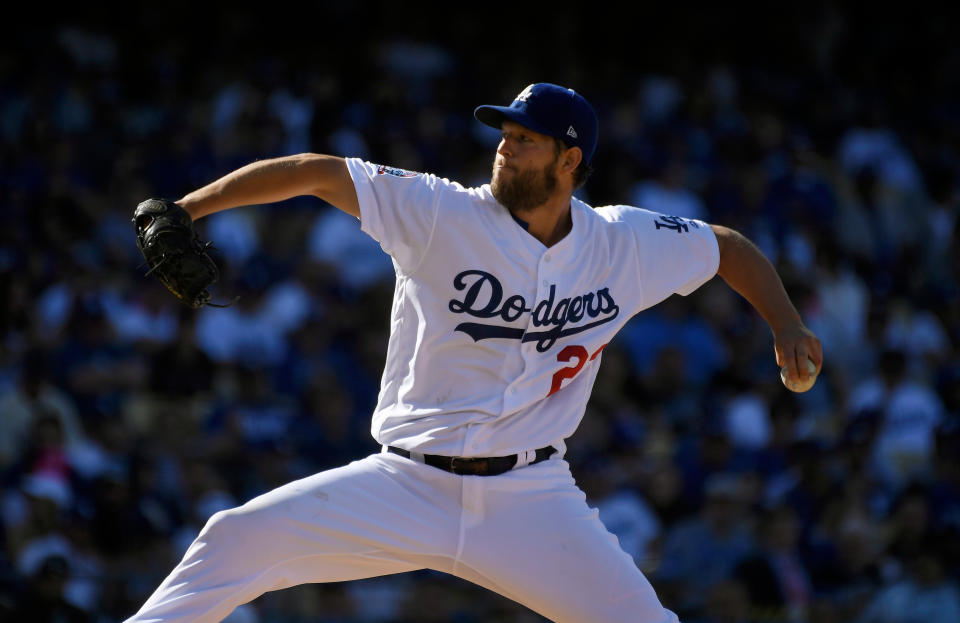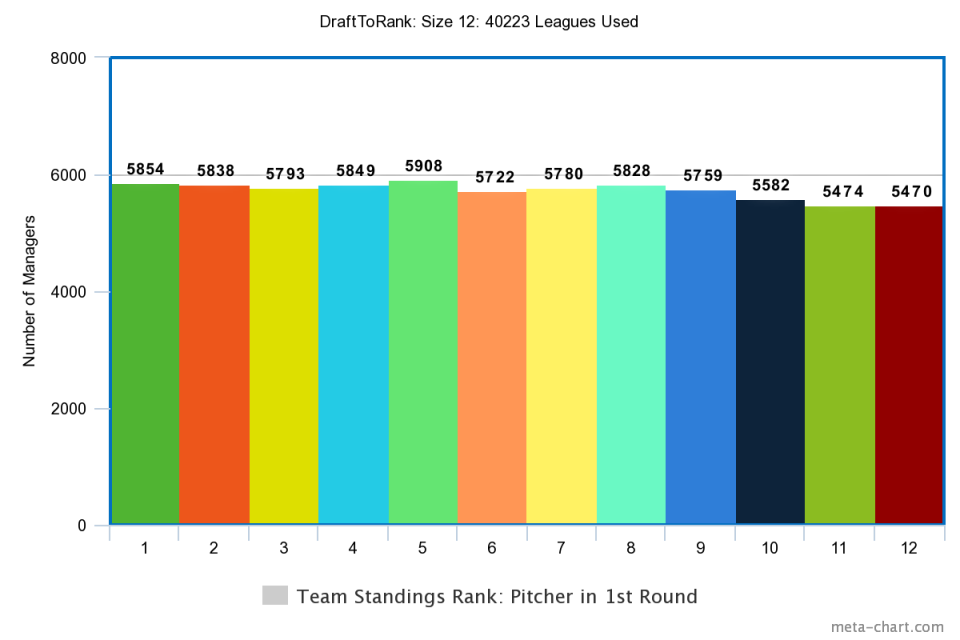How drafting a pitcher in the first round affects win probability

The 2018 draft season was far different than 2017 for the number of pitchers drafted in the first round on average.
Clayton Kershaw, Max Scherzer and Chris Sale typically were drafted in the first round of 12-team leagues. Just Kershaw and Scherzer in 10-team leagues. That’s 1-to-2 more teams per draft taking a first-round pitcher.
The question is whether this strategy is likely to increase win probability. Last year, in leagues of size 10 a total of 23,938 pitchers were picked in the first round out of 16,935 leagues which averages out to 1.41 pitchers picked in the first round per league (14.1%).
In leagues of size 12 a total of 68,857 pitchers were picked in the first round out of 40,223 leagues which averages out to 1.71 pitchers picked in the first round per league (14.3%).
Let’s see how teams fared based on their first round pick, pitcher or hitter. The charts show the distribution in the standings based on teams that picked a pitcher in the first round:


You can see that, in 2017, it was slightly more effective to take a pitcher in the first round late in the round in 10-team leagues. But in 12-team leagues, that was flipped. This could just be random noise. The main takeaway seems to be that there was no structural advantage last year in taking a pitcher in the first round versus a hitter.
Last year, Clayton Kershaw was the first pick and was hurt for a stretch, finishing with only 179 innings, or about 40 short of hopes but only about 20 less than consensus projections. Still, he earned $34 in Yahoo leagues, according to Patton & Co. His four year earnings are $40, $42, $34 and $34, according to Patton calculations. Scherzer earned $38 and Sale $37. Remember, neither pitcher threw as many innings as projected with Sale’s 214 not only topping the trio but all of baseball.
This year for the first year ever, I strongly advocated taking a pitcher or even two in the first three rounds. You hate to fight the last battle, but there is a steady trend in baseball with the number of ERA qualifiers declining to an all-time low of just 58 last year. I wrote about this trend in March in The Wall Street Journal.
The average number of innings thrown by starting pitchers has been on a steady decline. Only 58 pitchers pitched at least 162 innings last season. https://t.co/fFnmHOc5Ap
— WSJ Sports (@WSJSports) March 8, 2018
My sense is it’s so much harder to build a starting pitching foundation given that less and less pitchers are reliably piling up games and innings. Since 2014, the number of ERA qualifiers has dropped from 88 to 78 to 74 to 58. And the average frames that these qualifiers throw is down all the way to 184, about 20 less than the average just 20 years ago.
So what we’re chasing is not only the averages and strikeouts, but also the innings and most importantly the wins. There just are not many pitchers who pitch deep enough into games to be bankable for wins, a statistic I spent the first decades of my fantasy career profitably ignoring. Pitchers today average just 5.5 innings per start. But the handful of aces are closer to 7.0.
Last year, there were just 706 wins lasting less than six innings and 750 lasting six innings plus. So pitchers who pitch deeper into games, which of course is a proxy for overall effectiveness, too, are about twice as likely to come away with a win. The problem with pitchers who tend to average fewer innings despite their effectiveness is that you not only have to worry about the last two guys in the bullpen holding a lead, but the third and fourth arms, too. Witness Aaron Nola’s controversial opening week outing of just five shutout innings.
Less starter innings means that if you happen to get a dominant starter who stays healthy, he’s likely going to make up a higher percentage of your starting staff than ever before. Leagues with 1,400-inning caps are almost laughable now given how hard it is to field a staff to hit these marks. Remember, even if you are streaming starters, they are pitching far fewer innings — especially the streamable ones.
In high stakes NFBC leagues, where the prizes can top six figures, Corey Kluber was the 13th pick. But then things settled down with nearly a round before the next pitcher went. The market is definitely tiering/prioritizing the top four pitchers. Stephen Strasburg has never had a season approaching 200 innings, Noah Syndergaard missed most of 2017 with a torn lat, Luis Severino has done it just once, Jacob deGrom … well, I’m not sure what the issue with him is, to be honest. Maybe because he cut his hair.
The story of 2018 remains to be written, but the big bet players made was that early-round starting pitching was a bigger key to increasing their chance of winning. We’ll measure this year by how well those teams finished in the standings and that will doubtlessly provide the framework for how we value the pitching pool going forward.
More from Yahoo Sports:
• Pete Thamel: Can Condoleezza Rice save college basketball?
• Twins not happy with Oriole rookie’s bunt
• Dramatic finish in NCAA women’s title game
• Pat Forde: How Jay Wright transformed Villanova



